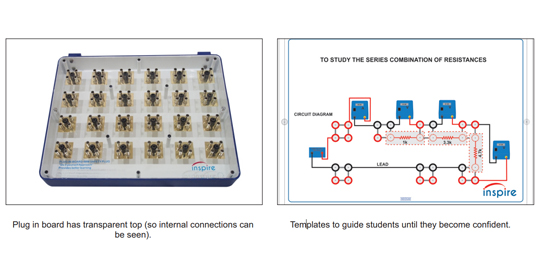RING LAUNCHER SV543
Ring launcher demonstrates Lenz’s law and effects of electromagnetically induced currents in a unique setup.
An iron core is placed in a solenoid. The ring fits over the coil at some height. When we press launch button on control panel to energize the coil, a large magnetic induction builds-up on the axis of coil, generating oppositely directed induced current in the ring. The two oppositely directed inductions repel, aluminium ring shoots up to several feet in air. No effect is seen when using aluminium ring with split or acrylic ring.
Transformer principle observed with coil of wire having low voltage lamp, which lights briefly. Overheating of coil is prevented by automatic one-shot timing feature. The ring launcher has several inbuilt interlocking safety feature along with speech for safe launching.


Experiments:
Exp-1 Diode characteristics of transistor junctions.Exp-2 Recording the characteristics of a transistor.
Exp-3 Recording the characteristics of a field-effect transistor.
Exp-4 To study half wave and full wave (bridge) rectifier.
Exp-5 To study capacitor filter effect in power supply.
Exp-6 To study unregulated and regulated power supply.
Exp-7 Recording the current-voltage characteristics of diodes.
Exp-8 Recording the current-voltage characteristics of zener diodes.
Exp-9 Recording the current-voltage characteristics of LED.
Exp-10 AND, OR, XOR, NOT, NAND and NOR operations.
Exp-11 De Morgan’s laws.
Exp-12 Logic operation using three and four variables.
Exp-13 To study MOSFET characteristics.
Exp-14 To study characteristics of TRIAC.
Exp-15 To Study Ohm’s Law.
Exp-16 To Study Kirchoff’s Law.
Exp-17 To Study Series & Parallel Effect of Resistance.
Exp-18 To Study Resistances As AVoltage Divider.
Exp-19 To Study LDR Characteristics.
Exp-20 To Study Thermistor Characteristics.
Exp-21 To study the R-C Circuit.
Exp-22 To study the L-R Circuit.
Exp-23 To study the L-C-R Circuit.
Exp-24 To study the Clipper and Clamper Circuit.
Exp-25 To study the Charging and Discharging of a Capacitor
Why Electronic Plug in Kit:
- Electronic plug-in kit is a comprehensive set of components for performing experiments in Analog and Digital Electronics.
- The plug-in modules include both passive and active electronic components with contacts formed by 4-mm plugs.
- The plug-in modules have a transparent housing for visibility of the component placed.
- The symbols and name of the component printed on each plug-in module, so student can easily identify.
- High quality reliable plug-in system with student support material.
- It is a “student-centred approach”.
- Participation in circuit assembling by students, promotes understanding, encouraging own-designed circuits.
- The freedom to experiment is backed up by formal experiment literature.
- It leads to knowledge and valuable practical skills.
- It provides you best electrical safety while performing an experiment.
Key Features:
- Clear view of circuits.
- Safe and easy to setup.
- Reliable connections.
Scope of Supply:
| Cat. No. | Item Name | Qty. |
| CB530 | AND Gate Module (Single Gate) | 2 |
| SEB14 | Capacitor Module 0.01µF | 3 |
| SEB72 | Capacitor Module 0.047µF | 2 |
| SEB15 | Capacitor Module 0.1µF | 3 |
| SEB16 | Capacitor Module 0.47µF | 3 |
| SEB73 | Capacitor Module 10µF | 3 |
| SEB74 | Capacitor Module 100µF | 1 |
| SEB17 | Capacitor Module 1000µF | 1 |
| CB534 | Ex-OR Gate Module (Single Gate) | 2 |
| SEB26 | Inductor Module 30mH | 2 |
| SEB75 | Inductor Module 60mH | 1 |
| SEB28 | JFET Module | 1 |
| SEB30 | LED Module | 1 |
| CB539 | Light Sensor (LDR) Module | 1 |
| SEB31 | MOSFET Module | 1 |
| CB531 | NAND Gate Module (Single Gate) | 1 |
| CB535 | NOR Gate Module (Single Gate) | 1 |
| CB532 | NOT Gate Module (Single Gate) | 2 |
| CB533 | OR Gate Module (Single Gate) | 1 |
| SEB38 | Push Button Module | 1 |
| SEC06 | Regulator Module | 1 |
| SEB41 | Resistor Module 100Ω | 1 |
| SEB43 | Resistor Module 330Ω | 1 |
| SEB46 | Resistor Module 1kΩ | 2 |
| SEB47 | Resistor Module 3.3kΩ | 3 |
| Plug-in-board | 1 |

